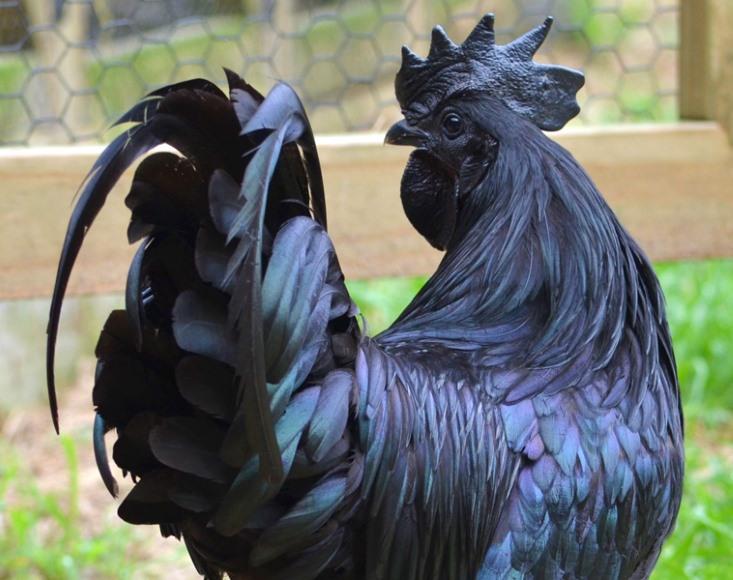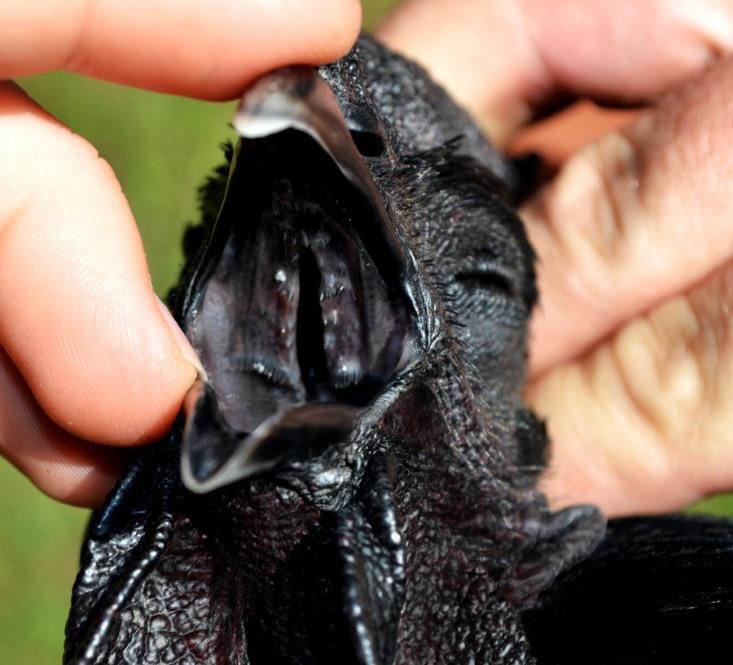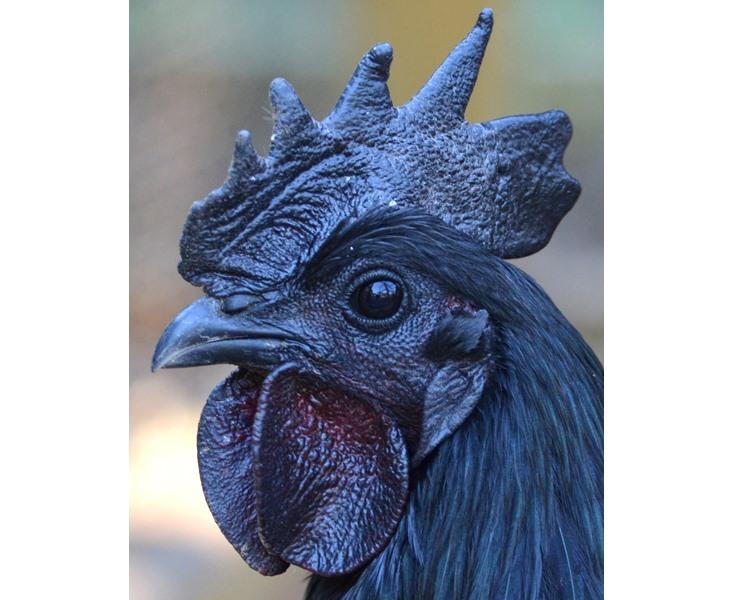In the historical novel The Black Tulip, written by Alexandre Dumas, an honest and decent Dutch tulip fancier is nearly brought to ruin by his quest to breed a purely black flower. More precisely, his misadventure is due to the dastardly schemes of his neighbor, who, frantic with spite and jealousy over the plants, frames him for a political crime and gets him thrown in jail. The potboiler plot is ridiculously overheated, but Dumas got one thing exactly right: People will go nuts over the desire to possess a living thing in a strange and beautiful color.
Almost 400 years after the Dutch tulip craze drove prices of some flowers to ridiculous heights, legions of U.S. poultry fanciers are now obsessing over another unusual breeding product: a chicken called the Ayam Cemani. The bird is inky black from the tip of its comb to the end of its claws, with blue-black skin, jet-black eyes, and a black tongue. It is covered in shimmering metallic black feathers, and even its internal organs are black. It is one Goth chicken.

The breed was developed in Indonesia, but due to concerns over avian flu, the U.S. Department of Agriculture bans direct imports from that nation. So these extraordinary chickens are very hard to get in America and, as a result, are extremely expensive. The best-known and most reputable breeder, Greenfire Farms, offers them for more than a thousand dollars per pair of juveniles; just one day-old chick of unknown sex goes for $199, plus shipping and handling. You can find Cemanis advertised for cheaper, but the discussion forums of backyardchickens.com (for example) suggest that you risk getting scammed. Order eggs off eBay and you might find yourself hatching out counterfeit chicks of silver or brown.
Cemanis are not the only black birds, but most of the others have pink tongues and deep brown eyes, along with innards of the normal hues. A few wild birds are naturally melanistic, meaning that due to genetic variations they have more pigment production in their feathers or skin. Their feathers are darker than usual, often brown or sooty grey. (See Nautilus’ story on the wide range of birds with abnormal colors.)
This phenomenon of internal blackness, which is called fibromelanosis, seems to occur in only three other oddball breeds: the Swedish Bohuslän-Dals svarthöna, the Vietnamese Black H’Mong, and the Silkie, an ancient breed of fluffy, five-toed chickens with feathers that look like hair. In 2011, a team of Swedish, American, and Chinese researchers figured out the genetics of this strange phenomenon. It was lead by Leif Andersson, a Swedish geneticist at Uppsala University who has long been interested in the genetic origins of striking phenotypes in livestock. The team discovered that fibromelanosis in all three breeds is caused by a mutation that affects how pigment-producing cells travel in the very early stages of development.
Normally, the precursor cells that will later give rise to melanin-producing melanocytes travel through the developing embryo in a specific pattern, winding up in the tissues that will develop into the skin and the eyes. In these birds, the cells also turn within, invading and colonizing tissues that will later turn into the fibers that hold the body together—the abdominal lining and the connective fibers and sheaths that encase the muscles and organs. There they continue to multiply instead of shutting down, resulting in significant deposits of dark color throughout the inside of the bird.
This genetic fluke is the result of two sizable chunks of DNA that are duplicated within the chromosome (one of them upside-down). Inside those stretches, Andersson’s group also pinpointed a gene called endothelian-3 (EDN3), known to be involved in the regulation of pigment-producing melanocyte cells. About 10 times as much EDN3 was expressed in the skin of adult black chickens than in other breeds. (The lovely black metallic sheen of the Cemani’s feathers actually has nothing to do with this variation; in fact, some Silkies have white feathers despite their black skin and black bones.)
The upshot was that although the team got the birds by way of China, Vietnam, Sweden, and Indonesia, they all shared the same genetic signature. The DNA tells the backstory: Long ago, a European traveler saw an all-black chicken somewhere in East Asia and brought it back to Europe to raise. “What is interesting is that all chickens with this phenotype carry exactly the same mutation,” says Andersson. “It suggests that some humans saw these black birds and were excited about them, kept them, and sold them and they spread over the world.”

On the Indonesian island of Java, the Cemani has a long history. Traditionally a bird of the elites and the courts, it is rarely found in the markets and is not eaten for food. It is a chicken with exalted status, used in rituals that date back to the pre-Islamic era, perhaps as long ago as the 12th century, says Veronika Kusumaryati, who is studying toward a PhD in the anthropology department at Harvard University. (She is originally from Yogyakarta in Java, and her grandmother used to raise Cemanis for sale.) The blackness of the Cemani makes it a preferred go-between, an emissary between the human and the supernatural world. In traditional Javanese culture, “the world is occupied by spirits, good and bad, whose power can be mobilized to help people to gain power, reputation, and wealth,” she writes. “For these purposes, one should offer Cemani chicken, as the ghost and spirits love Cemani chicken’s meat and blood.”
Today, before undertaking a major project—like running for office or starting a business—a Javanese might first go to a shaman who sacrifices the black bird with great care in order to provide the spirits with something they love. But the wealthy in Java also keep them because they are glamorous, just as bird fanciers do in the U.S.
Paul Bradshaw, the owner of Greenfire farms, began importing the birds a few years ago from a breeder in the Netherlands who he thought had the best stock outside Indonesia. At the time, a few people were selling Cemanis in the U.S., but many were dodgy, he says, running ads that just showed one foot of the bird rather than the whole thing. His birds had good bloodlines and reliably produced all-black chicks, and pretty soon, the Cemani was the chicken of the moment. The first pair of birds he sold went for $5,000. “You never know what’s going to galvanize the imagination of the public,” he says. He estimates that he’s sold about 500 Cemanis in the past few years.
When Bradshaw first began importing rare chicken breeds, building up domestic flocks and charging good prices for the progeny, other breeders laughed at him. The chicken-breeding business was supposed to compete on price, not rarity or beauty. “It was a disruptive concept,” he says. Eventually, the growing poultry craze proved him right. He now offers a few dozen specialty breeds—including the Swedish svarthöna, which looks a lot like a Cemani but does well in cold weather. It’s also a relative bargain, at $99 per chick.
Bradshaw enjoys raising the birds, and he builds and maintains breeds that don’t make him any money just to keep the heirloom genetics going. But ultimately, Greenfire responds (or creates) the whims of chicken fanciers. “Somebody who plunks down $1,500 for a Williams-Sonoma chicken coop, they want an artisanal chicken breed,” he says. “They want something special, with a story, something beautiful. That’s the market we serve.”

In his studies of domestic animal genetics, Andersson has seen this quirk of human psychology again and again: People seek out and maintain genes that produce animals of amazing colors, even at great cost. A few years ago, his group determined that all white horses around the world share the same ancestral coat color variation. The mutation happened once in the history of horsedom, probably about 2,000 years ago, and it predisposes white horses to melanoma and a shortened life span. Nonetheless, humans maintained it and spread it around the globe. More recently, a brick-red-and-white variation has emerged in the traditionally black-and-white Holstein cow, the world’s main milking breed. There’s no evidence that it is more productive or healthier, says Andersson, but it is popular: “If almost all cattle are black, and you get red ones, people like it.” In the sequences of these animals’ DNA, he sees the proof: They may say it’s all about meat or eggs or milk or muscle, but in the end, people prize animals that just look good.
Kat McGowan is a contributing editor at Discover magazine and an independent journalist based in Berkeley, Calif., and New York City.
WATCH: Mazviita Chirimuuta, a philosopher of perception, has a new theory of color.

This classic Facts So Romantic post was originally published in August 2015.






























